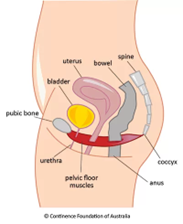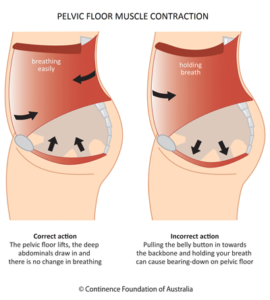What is the pelvic floor?
The pelvic floor is a sling of muscles, tendons, ligaments and connective tissue that extends like a hammock from the pubic bone to tail bone (coccyx). (See red sections in images)


Why is the pelvic floor important?
The pelvic floor muscles provide several key functions;
- Support of the organs within the pelvis – bladder, bowel, and uterus and vaginal canal (in females), and prostate (in men).
- Help maintain bladder and bowel control.
- Support clitoral and penile arousal, ability to have an erection, and ability to have orgasm.
- Stabilisation of the hips, pelvis and lower back
When pelvic floor muscles become weakened or dysfunctional, you may not be able to correctly contract (lift) or relax these muscles which can lead to :
- prolapse (bulging) of pelvic organs into the rectum or vagina
- reduced ability to ‘hold on’ to bladder or bowels causing urinary leakage, or complete incontinence of urine or faeces (poo)
- pain during/after sex or erectile dysfunction in men.
There are a number of reasons why pelvic floor muscles can weaken or become dysfunctional including pregnancy/childbirth and menopause (in women), heavy lifting, straining on the toilet, chronic coughs, high impact exercising, obesity, and aging.
How can your pelvic floor be impacted by cancer or cancer treatments?
Cancer and cancer treatment can have significant impact on pelvic floor.
Cancer: Cancer of the bladder, bowel, rectum and anal canal, gynaecological cancers (endometrial, ovarian, cervical, vulvar and vaginal), and prostate cancer can all impact on the pelvic floor muscles and contribute to pelvic floor dysfunction.
Surgery: Surgical procedures within the pelvic region such as tumour debulking, bowel resections, hysterectomy, oophorectomy (removal of ovaries), and prostatectomy can affect pelvic floor function through swelling and scarring of the pelvic floor muscles.
Radiation, chemotherapy, hormone blocking therapy: Radiation therapy (both external beam radiation and internal brachytherapy) to the pelvic region can cause hardening (fibrosis) of the pelvic floor muscles which can cause pelvic floor dysfunction; as well as cause narrowing of the vaginal canal. Chemotherapy and hormone blocking therapies can cause weakening of the pelvic floor muscles.
What can you do?
Like any other muscle in the body, pelvic floor muscles can be trained and strengthened with targeted pelvic floor exercises – but like all exercises it is important that you are doing the exercises correctly to ensure you get the best benefit from the exercises, as well as ensuring you aren’t making the problem worse.
The first thing to do is make sure you are correctly identifying the pelvic floor muscles:
Men:
- On the toilet – try to stop or slow the flow of urine midway through emptying your bladder. If you can do this you are squeezing the correct muscles. Only try this method once per week. If you do this too often your bladder may not empty the way it should.
- Sit or lie down with the muscles of your thighs, stomach and buttocks relaxed. Squeeze the ring of muscle around the anus (back passage) as if you are trying to stop passing wind. Now relax this muscle. Squeeze and let go a couple of times until you are sure you have found the right muscles. Try not to squeeze your buttocks.
- Stand in front of a mirror with no clothes on. Pull in your pelvic floor muscles strongly and hold them. You should see the penis draw in and your scrotum should lift.
Women:
- Imagine stopping yourself from peeing and pooing, and contract these muscles simultaneously. Or, insert a finger into the vagina and try to tighten the muscles around your finger. These are the pelvic floor muscles. It should feel like a ‘squeeze and lift’. This can be done standing, sitting or laying down.
Once you can identify and contract your pelvic floor muscles correctly, try holding the inward squeeze for up to 8-10 seconds before relaxing. If you feel comfortable doing this, repeat it up to 10 times, resting for 8-10 seconds in between each squeeze. This can be done three times a day. Make sure you continue to breathe normally while you squeeze in.
You can do the exercise lying down, sitting or standing with your legs apart, but make sure your thighs, bottom and tummy muscles are relaxed.

To learn more about how to identify and exercise your pelvic floor muscles follow below links:
Pelvic floor muscle exercises for women
Pelvic floor muscle exercises for men
If you are having trouble identifying and exercising your pelvic floor muscles then it is important to speak to a pelvic floor physiotherapist, or a continence nurse who can assess your pelvic floor function, and help you identify and exercise your pelvic floor correctly. You can speak with a continence nurse at Continence Foundation of Australia by calling 1800 33 00 66. You can find a pelvic floor physiotherapist where you live via this link (refine your search and select specialist physiotherapist).
Helpful resources:
- Continence Foundation of Australia
- Pelvic Floor First
- Cancer Council – Pelvic Floor
- National Public Toilet Map App – an app to install on your phone to help you locate the closest public toilet.
All information provided by Bloomhill is based on research and best practice guidelines. Our model of care utilizes the Clinical Oncology Society of Australia (COSA) domains of wellness along with available clinical evidence. Always consult your care team regarding matters that affect your health. This is a guide intended for information only.



